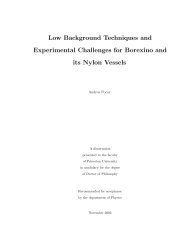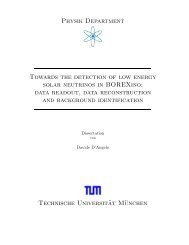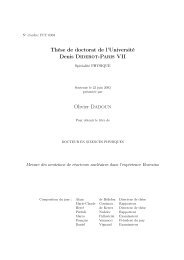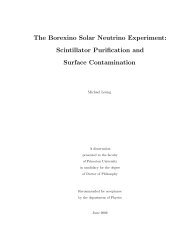Development of a Liquid Scintillator and of Data ... - Borexino - Infn
Development of a Liquid Scintillator and of Data ... - Borexino - Infn
Development of a Liquid Scintillator and of Data ... - Borexino - Infn
You also want an ePaper? Increase the reach of your titles
YUMPU automatically turns print PDFs into web optimized ePapers that Google loves.
6 Test <strong>of</strong> a PXE based scintillator for <strong>Borexino</strong><br />
volumetric exchange with water from the Inner Vessel. To avoid overpressure <strong>of</strong> the Inner<br />
Vessel, a few 100 l water were pumped out <strong>of</strong> the Inner Vessel prior to the filling. During the<br />
filling the pump was working in a mode, that it pumped water out <strong>of</strong> the Inner Vessel into<br />
the buffer tank, <strong>and</strong> the scintillator was pushed in a passive mode out <strong>of</strong> the buffer tank into<br />
the Inner Vessel. Once the filling was completed, the Inner Vessel was isolated, <strong>and</strong> the water<br />
was drained from the buffer tank. Then the tank was dried with nitrogen <strong>and</strong> was then ready<br />
to be filled again with the next batch <strong>of</strong> scintillator. The filling <strong>of</strong> the total volume <strong>of</strong> PXE (4<br />
tons) was realized in three batches (1 ton, 2 tons, 1 ton). The data taking with the CTF2 can<br />
be divided into 5 different phases:<br />
1. Water Run: The data acquisition was first running from March 19 to March 31 (run<br />
706 - 716). At that time, the Inner Vessel was filled with water. These runs were used<br />
to calibrate the electronics; <strong>and</strong>, by measuring the Cerenkov light from muons crossing<br />
the detector, to develop criteria to reject these Cerenkov events.<br />
2. 1 Ton Runs: The first ton <strong>of</strong> PXE was filled in the CTF on June 3rd 2000. The Inner<br />
Vessel used in the CTF2 had several small leaks bearing the risk <strong>of</strong> enlarging under<br />
stress. Therefore we filled only 1 ton <strong>of</strong> PXE in the beginning in order to keep the<br />
buoyancy small. <strong>Data</strong> was taken from June 4th to June 9th (run 717 - 723). After it<br />
turned out that there were no substantial leaks, we continued the filling.<br />
3. 3 Ton Runs: Another Ñ were inserted in the IV on June 11th 2000. <strong>Data</strong> was<br />
taken from June 13th until July 15th (run 724 - 757).<br />
4. 4 Ton Runs: The remaining amount <strong>of</strong> PXE was inserted on July 15th 2000. The data<br />
taking period with 4 tons <strong>of</strong> PXE, without any scintillator operations, lasted from 16th<br />
July 2000 until 6th September 2000, i.e. about 6 weeks in total (run 758 - 789).<br />
5. Source Test: From September 12 until September 20 we carried out a number <strong>of</strong> calibration<br />
measurements with a localized source introduced into the Inner Vessel (run 790<br />
-810). The source was placed at various locations inside the Inner Vessel to test the<br />
homogeneity <strong>of</strong> the detector response <strong>and</strong> the systematic effects <strong>of</strong> the position reconstruction.<br />
The results <strong>of</strong> these tests will be reported in chapter 7.<br />
At the end <strong>of</strong> September 2000, the scintillator was unloaded from the Inner Vessel into one EP<br />
tank by volumetric exchange with water. Later, the PXE was removed from the Module-0 <strong>and</strong><br />
placed into storage for later use in another experiment. The water was drained from the CTF<br />
tank so that the leaky Inner Vessel could be replaced.<br />
86








